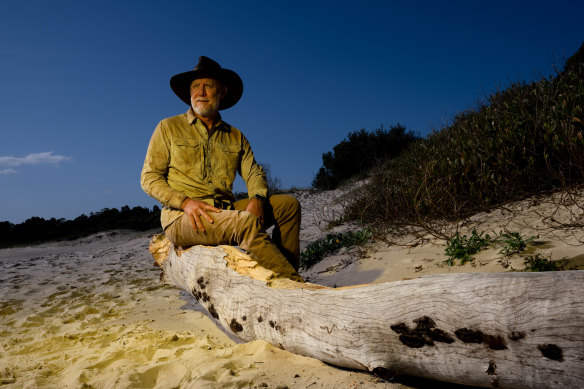Australia’s brutal Simpson Desert with its inescapable dunes and cantankerous winds nearly beat solo adventurer Dr Geoff Wilson. He has crossed the ice of Antarctica and sands of the Sahara in kite sleds and buggies powered by wind, but Wilson thought the Simpson would be death of him.
In the last of three attempts over 11 years, Wilson succeeded last week. He is now the first person to have completed a solo wind-assisted crossing of the Simpson Desert.
Dr Geoff Wilson has successfully crossed the Simpson Desert on board his kite buggy earlier this year.Credit:Janie Barrett
“It just felt like a war every day; the desert was just trying to kill you,” he said. “The [wind] is so variable. It would be like trying to drive somewhere with a monkey jumping on the accelerator every two minutes.”
It took Wilson seven kites and 12 days to traverse 570 kilometres thick with thorns and riddled with inland taipans – the world’s most venomous snake – on the track running from Queensland’s outback town of Birdsville to near Alice Springs, in the Northern Territory.
When there was no wind, the 52-year-old Wilson “man hauled” the 95-kilogram buggy. He did that for 120 kilometres, about 20 per cent of the way, over 350 dunes.
“The wind is fickle. It will change direction three times a day and generally, it is against you, not with you. The combination of the vegetation, the thorns, the taipans, the dirty air and dunes mean that it’s a very, very hard desert to cross.”
On the days without wind, the Queensland vet surgeon wouldn’t travel more than 20 kilometres.
As his buggy bounced up and down, thorns and burrs turned his behind into “a hairbrush”, he said on Thursday. He’s still picking them out.
That would have been enough to send most adventurers packing, but the August attempt was his last chance. Wilson had promised his wife Sarah that he would concede the Simpson was uncrossable if this attempt failed.
His goal? “A grand adventure, without being killed.”
Wilson dedicated the trip to the local Wangkangurru and the Yarluyandi people. “I want to raise awareness about the damaging effect of our carbon emissions on our sacred wilderness and show how we can make changes for the better.”
After seeing the impact of climate change in Antarctica and Greenland, Wilson would like to promote wind power adventures as a way of exploring with reduced or zero emissions. This attempt, though, required a support team that drove ahead to clear 4WD traffic.
Wilson told the Herald that his solo wind adventure across Antarctica seemed “calm and consistent, easy” compared to the Simpson. There “beautiful winds would provide 48 hours of continual wind pressure at five knots and open space.”
But the wind of the Simpson was capricious, as one of his posts on Instagram illustrated: “Broke my own daily desert mileage record today – 119 kilometres in a single day.”
“The gusty winds blew all day and with only three kite/tree incidents and minimal breaks our little team managed 11 hours of continual movement northwards – sometimes breakneck speeds at other times at a mere crawl. 119 kilometres of getting smashed in a buggy across rough desert feels like a 300-kilometre day on ice.”
A dead inland sea, the Simpson dunes run parallel for up to 600 kilometres, say Australian scientists. There is no way to cross using valleys like Simpson did in the Sahara Desert. “This is up and over,” he said.
Gusts of wind lifted Simpson off the buggy 50 to 60 times. “On one occasion, I was picked up, and the kite went into a power loop because the wind was like a tornado. I just got drilled head-first with a helmet into the sand. You could break your neck easily.”
Realising that hauling his buggy would exhaust him to the point of giving up, he took the advice of a specialist meteorologist, Marc De Keyser, in Belgium.
After one big day of man hauling, De Keyser told him the wind would be perfect the next afternoon.
Wilson’s wind adventures
- Sahara Desert: 2450km, 42 days in 2009
- Greenland: 2500km, 18 days in 2017
- Antarctica: 5316km, 58 days in 2020
- Simpson Desert: 570km, 12 days in 2022
“We sat around, played checkers and had lunch. At 2.30pm, I started to lay out the kite in the direction that the wind would come. By then it was coming 180 degrees in the wrong direction. At three pm, it was 90 degrees off. By half-past three, as forecast, it was perfect.”
In the two hours before dark, the wind powered him 46 kilometres.
Wilson discovered a passion for kite-assisted travel while crossing the Sahara in 2009 when he traversed six African countries over 2500 kilometres. “Now less than 12 years later, there’s nobody who has covered more ocean sand and ice using kites.”
When he crossed the Sahara, his team worried about bandits stealing gear. To generate goodwill, the advance team went ahead to each village to hand out small octopus-shaped kites to children. As they’d arrive, they would see groups of up to 40 children flying the kites with their tentacles trailing.
“There’s something about the single string kite, the four string kite, that stirs the human soul,” he said.
The Morning Edition newsletter is our guide to the day’s most important and interesting stories, analysis and insights. Sign up here.
Most Viewed in National
From our partners
Source: Read Full Article

